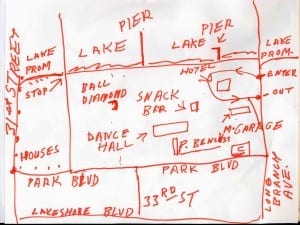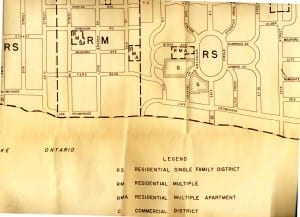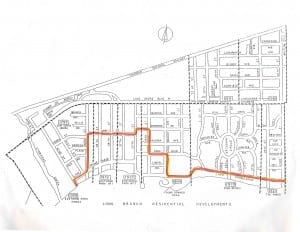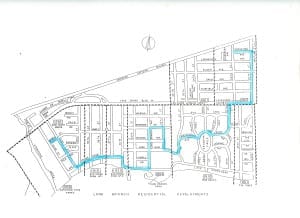John Stewart of Wiarton has added a comment to a previous post about the 1958 fire at the Long Branch Hotel

Long Branch Hotel map. Bill Rawson, May 2013

A map from the Long Branch Historical Society shows the shoreline of Lake Ontario as it existed during the years before the Long Branch Hotel burned down.

Part of the route for the May 4, 2013 Jane’s Walk in Long Branch is indicated on a Long Branch subdivisions map. The map shows where infill was added to the shoreline at a relatively recent stage of the community’s history. It may also be noted that before the infill, Lake Promenade did not extend in front of the property where the Long Branch Hotel was located. It terminated on either side of the property as the previous map (please see directly above), from the Long Branch Historical Society, indicates.

June 28, 2016 Long Branch Urban Design Guidelines Walking Tour route, superimposed on Long Branch Subdivisions map. Click on image to enlarge it.
John Stewart of Wiarton has added a comment to a previous post about the fire at the Long Branch hotel; he writes:
“Our family grew up on 31 Arcadian Circle from 1939 to 1998. I remember the Long Branch hotel fire and even have slide pictures of it. It actually was during the winter early in the new year as I too remember how big the rats were and how bitterly cold it was that the rats ran back in. My father in law Harold Hall a volunteer fireman fell from the top floor into the basement when the floor caved in and injured his back.The next day all that was left standing were the old cast iron pipes still sticking up and the basement walls thick with ice. My sisters and I went to the old James S. Bell school where I met my future wife June Underhill of Ash Crescent in Mrs. Salter’s grade six class. My wonderful memories of Long Branch are more than I could ever hope to put on line. I now live in Wiarton and love to tell my friends there the stories of growing up in Long Branch. Thanks for creating this site.”
Thank you, John
Thank you, John, for posting this comment. I am delighted to read your corroboration of a previous comment regarding the rats. It is comments such as your that truly add value to this website. Would it be possible for us to post some of the slides that you mention? Please contact me if it may be possible for me to arrange to get jpeg images of the slides. I am very pleased that this website enables us to share such great stories about Long Branch of years ago. I have made a point of posting your comment as an additional, separate post, by way of bringing attention to the previous post and all of the great comments that have been added to it:
A Long Branch resident passed along to Barry Kemp this photo of the Eastwood Park Hotel
The text at the latter site brings to mind for me how much I’ve learned about Long Branch history in recent years, starting with the fact that few biographical details about Colonel Samuel Smith, the first European settler in Long Branch, are available:
Colonel Samuel Smith and the management of organized violence (which, as it turns out, is what military leadership entails)
Some years ago, I developed an interest in the story of Colonel Samuel Smith, about whom I have written at some length in years past, at this website. There is relatively little known, by way of archival and historical evidence, regarding the colonel, who in the late 1700s and early 1800s owned all of the land that is now known as Long Branch, the Toronto neighbourhood where I have lived for 20 years, and who owned land beyond the borders of Long Branch as well.
Because little is known about the colonel, in the historical record, I began to read about the history of the British empire, First Nations history, and the world history of warfare. Such reading has enabled me to get a good understanding of what the colonel’s life and career – and the life and career of a friend of his, John Graves Simcoe, about whom more biographical details are known – were about. Biography can only explain a finite amount about a person’s life and behaviour. That’s a key insight that I have gained, from my study of the context of Colonel Samuel Smith’s life, and from my other study in recent years of aspects of local, regional, national, and world history.
The above-noted comments about Colonel Samuel Smith tie in with my current study of namthe theory and practice of story management.
A library book available at the Long Branch Library claims the Long Branch Hotel burned down in 1955. The correct date is 1958. Similarly, the colonel’s log cabin, built in 1797, was bulldozed in 1955 not 1952. I like to keep track of such details, as I like to adopt an evidence-based approach to the study of local history. That means I like to do fact-checking, rather than repeating what some other amateur historian (I am an amateur historian myself) has said.
Click on the images to enlarge them; click again to enlarge them further
From time to time, I mention the Long Branch Historical Society. It’s my hope that in maybe 20 years, the society will be up and running again. Some years ago, it ran into organizational issues and went into a prolonged state of dormancy as a result. I owe thanks to the fact that, while it was in operation, it gave rise to valuable networking opportunities for me among other people. In posts in recent years I’ve also mentioned the launch of the Long Branch Neighbourhood Association. The foundations for the latter association are well in place. I know that because I was involved in the discussions, which involved input from many residents, leading to the development of its bylaws and operating structure. It’s my hope that the latter association will be up and running in the next while. Such an association has the potential to add much of value to our community.

Leave a Reply
Want to join the discussion?Feel free to contribute!